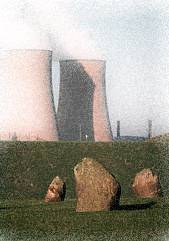 Fletcher Prouty is an all-purpose guru on matters involving the Kennedy assassination, U.S. intelligence, and myriad other subjects. Well-loved in conspiracy circles, a collection of his commentaries can be found at:
Fletcher Prouty is an all-purpose guru on matters involving the Kennedy assassination, U.S. intelligence, and myriad other subjects. Well-loved in conspiracy circles, a collection of his commentaries can be found at:
The one we will be discussing here can be found on archive.org.
The commentaries make interesting reading, but unfortunately he's utterly unreliable in his use of "facts." For example, one of Prouty's commentaries is on a nuclear accident in England at a plant called "Windscales" [sic].
First of all, it's called Windscale, singular not plural. But Prouty goes on:
"A new Nuclear Development plant that they were designing in England and building went critical. They could not turn the thing off. It was as if you went to turn a light bulb off and instead of it turning off, the thing became ten times brighter, and forever!"The Windscale plant had been operational since 1950, supplying weapons grade plutonium for the first British atomic test in 1952. At the time of the accident, they were attempting to anneal the graphite moderators. To do this the pile was heated by withdrawing a few control rods just enough to increase the temperature but not enough to make the pile go critical. The pile never went critical!
"This plant at Windscales, went critical. It was so serious, it was the worst nuclear incident before the one in Chernobyl, in the Soviet Union."The operators overheated the graphite which started a fire. It was the fire which caused the release of the radioisotopes, not a criticality accident.
"So they rounded up all the bulldozers, all the road graders, all the earth- moving equipment they could get. Effectively they began to build a hill, a mountain right over the top of Windscales to contain the damage that there was no other way to get to."Nope. They poured oil into the reactor building to prevent the release of radioactive materials.
The new Twilight Zone series did a story where a nuclear accident site was buried. I think the colonel is confusing something he saw on TV with fact.
"What had happened in the earlier days of nuclear development, the nuclear industry itself, and for many of it's manufacturers, was a major change in the way they made things. In making the rods that are used to moderate the activity in a nuclear plant, you had to have carbon.They knew exactly what the rods had to be made out of."Before the dawn of the nuclear age pure carbon met certain standards of purity, and that was good enough. But in the nuclear era, pure carbon had to be completely pure and all of what you might say was the rare earth content had to be extracted from the carbon.
"Well, they hadn't built one of these nuclear things before and they didn't realize that, so the carbon had not been purified the way it had to be."
"When they put the rods in, they not only increased the activity but as they went to take them out, the rare earth bits that were left in the carbon rods excited the activity and it went critical."You don't take control rods out to stop the reaction, you put them in!
"It's still critical, it's still boiling."What is boiling? Windscale was air-cooled, not water-cooled.
"Well after all these years, the British government is still suing newspapers and other publications demanding that they not mention Windscale. Now what a ridiculous thing to think that there is any kind of secrecy or security that would be worth applying to a project 40 years after it happened, And my goodness millions of technicians know about it, they have all told each other. I heard it in a briefing in the Pentagon, within days of when it happened.A great website to read about the accident is here:"Secrecy is a tool that is applied when the government doesn't want you to know they are doing something that probably they shouldn't be doing anyway."
http://www.border-tv.com/wind/wind.htm
Ironically, it is the transcript of a TV documentary! So much for government censorship!
When I first read Prouty's commentary on Windscale I suspected he was confusing Windscale with something else. A "Twilight Zone" episode where a nuclear accident was buried was the first thing to pop into my mind but then I saw a web site that made everything clear. The control rods at Chernobyl had graphite tips and when they were inserted in an attempt to shut down the reactor, the graphite increased the activity! So Prouty not only confused the control rod issue (they did increase the activity when inserted but they were not the cause of the accident; they were not improperly designed) but he completely confused Chernobyl with Windscale!
It's all on PBS' web site:
http://www.pbs.org/wgbh/pages/frontline/shows/reaction/readings/chernobyl.html
As for Windscale being covered over: the plant is still in operation, and the reactor where the accident occured is still standing, although contained in a massive bioshield box (rather than covered over with a mountain of dirt).